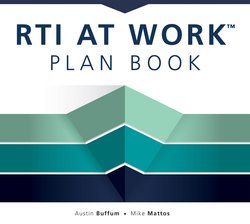Читать книгу RTI at Work™ Plan Book - Austin Buffum - Страница 10
На сайте Литреса книга снята с продажи.
ОглавлениеThe Foundation: Being a Professional Learning Community
An individual teacher working in his or her own classroom cannot effectively provide all three levels of RTI support. Instead, it requires schoolwide, collaborative efforts in which the entire staff takes collective responsibility for student learning. To make this point as clear and explicit as possible: being a professional learning community is an essential prerequisite to successful RTI implementation. Specifically, we advocate for the Professional Learning Community at Work (PLC at Work) framework, originally developed by Richard DuFour and Robert Eaker (1998).
Structuring a school as a PLC creates the foundation required to build a highly effective system of interventions. This foundation is grounded in the three big ideas of the PLC at Work process: (1) a focus on learning, (2) a collaborative culture, and (3) a results orientation (DuFour, DuFour, Eaker, Many, & Mattos, 2016).
A Focus on Learning
A PLC school’s core mission is not simply to ensure that all students are taught but also that they actually learn. As Richard DuFour, Rebecca DuFour, Robert Eaker, Thomas Many, and Mike Mattos (2016) state in the PLC handbook Learning by Doing:
The first (and the biggest) of the big ideas is based on the premise that the fundamental purpose of the school is to ensure that all students learn at high levels (grade level or higher). This focus on and commitment to the learning of each student are the very essence of a learning community. (p. 11)
This seismic shift from a focus on teaching to a focus on learning requires far more than rewriting a school’s mission statement or creating a catchy “learning for all” motto to put on the school’s letterhead. This commitment to ensuring student learning unites and focuses the collaborative efforts of the staff and serves as the organization’s “north star” when making decisions. The school’s policies, practices, and procedures are guided by the question, Will this help more students learn at higher levels?
Creating consensus and commitment to becoming a learning-focused school or district is an essential prerequisite to successful RTI implementation. Likewise, any school already committed to the PLC process would heartily embrace RTI as an essential tool in achieving its commitment to guarantee every student’s success.
A Collaborative Culture
The second big idea is a commitment to creating a collaborative culture. Because no teacher can possibly possess all the knowledge, skills, time, and resources needed to ensure high levels of learning for all his or her students, educators at a PLC school work collaboratively and take collective responsibility for student success. Instead of allowing individual teachers to work in isolation, teacher teams become the fundamental structure of the school. Collaboration does not happen by invitation or chance; instead, frequent team time is embedded into the contractual day.
Creating collaborative teacher teams will not improve student learning unless their efforts focus on the right work. To this end, four critical questions guide teacher collaboration in the PLC at Work process:
1. What knowledge, skills, and dispositions should every student acquire as a result of this unit, this course, or this grade level?
2. How will we know when each student has acquired the essential knowledge and skills?
3. How will we respond when some students do not learn?
4. How will we extend the learning for students who are already proficient? (DuFour et al., 2016, p. 36)
Question 1 requires teachers of the same course or grade level to collectively determine what they expect all their students to know and be able to do. After all, a school cannot possibly create a systematic, collective response when students do not learn if individual teachers focus on different essential learning standards. By identifying essential standards, teacher teams can analyze, prioritize, and otherwise unpack standards of what is most essential for students to know. We refer to this process as concentrated instruction—a systematic process of identifying essential knowledge, skills, and behaviors that all students must master to learn at high levels and determining the specific learning needs for each student to get there.
Because the school is committed to all students learning these essential standards, teams must be prepared to identify students who require additional time and support. This process is captured in the third big idea.
A Results Orientation
The third big idea focuses on evidence of student learning. In order to assess their effectiveness in ensuring all students learn, educators must use “evidence of learning to inform and improve their professional practice and respond to individual students who need intervention and enrichment” (DuFour et al., 2016, p. 12).
After identifying the knowledge and skills that all students must learn, collaborative teams focus on critical question 2: How will we know when each student has acquired the essential knowledge and skills? Educators functioning as a PLC must assess their efforts to achieve high levels of learning for all students based on concrete results rather than good intentions.
Student assessment information constitutes the life-blood of an effective system of interventions; teachers use it to identify students in need of additional time and support and to confirm which core instructional strategies are most effective in meeting students’ needs.
By answering the first two critical questions, the school is now prepared to successfully intervene for students who need extra help mastering essential curriculum, and it is prepared to extend the learning for students who have. These two outcomes are captured in critical questions 3 (How will we respond when some students do not learn?) and 4 (How will we extend the learning for students who are already proficient?).
